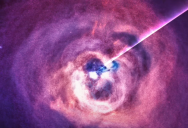NASA Has Finally Recorded A “Song” Coming From A Black Hole

I think humans have been fascinated with black holes for some time, and the reason for that is probably just that they’re a really interesting mystery.
Human beings have always been fascinated, after all, with the things we can’t explain – or the things we can’t see with our own eyes but would really like to.
And while we can’t show you what it looks like inside, thanks to NASA, you can hear what it sounds like. So take a listen.
The recordings – called sonifications – are of two black holes, and the results are just as eerie and ethereal as most people could ever have wanted them to be.
To capture these sonifications, a team of scientists at NASA’s Chandra X-ray Observatory extracted previously identified sound waves from a 20-year-old image of the Perseus galaxy cluster.
This cluster is so full of galaxies it’s one of the most massive objects in the (known) universe).
Kimberly Arcand, a Chandra X-ray Observatory’s visualization scientist, led the research.
“This sort of bespoke method is really about extrapolating something new out of this archival information.”
The process for translating scientific data into acoustic signals has become much easier in recent years, and all researchers need is a bunch of numbers to turn them into musical notes.
They use computer programs like Python, a publicly available sound engineering software.
The resulting “deep magnetic groaning” was created by a “supermassive black hole causing a rippling in its surrounding environments.”
The original notes are pitched too low for the human ear to detect, so in order to bring us the sounds, researchers had to resynthesize its signals by changing that upward.
“There are a number of areas in astrophysical research specifically where there’s really big data, or really noisy data. Having a human sense of hearing can be an excellent way of picking that good data out.”
The process will work on more than black holes, too, and astronomers and astrophysicists are dying to get a listen at the wider universe.
“In some cases, there are real musical rhythms and patterns in the cosmos. Bringing that to life, I think really helps connect something that’s very abstract and technical, with something that’s very personal and familiar, which is music.”
They’ve created an entire album of Chandra’s observations, called A Universe of Sound.
“The connection between music and astronomy has gone back to Pythagoras over 2,000 years ago. But lately, there’s been a huge explosion of sonification in general, especially in astronomy.”
Recently, researchers made recordings of auroral sounds that prove the northern lights are present even when invisible to the naked eye.
Creating music from data does require some perspective and artistic expression; it’s not all just ones and zeros.
Like all art, it has the ability to touch people – like Christine Malec, who works with the project to improve the accessibility of their sounds, since she is blind.
“When I heard my first sonification I had goosebumps. It was a visceral, sensory experience that I’d never had before with astronomy.”
Experiences like this are worth it, no matter how long it takes.
Or how far out there you have to go to retrieve it.
Thought that was fascinating? Here’s another story you might like: Why You’ll Never See A Great White Shark In An Aquarium

Sign up to get our BEST stories of the week straight to your inbox.




